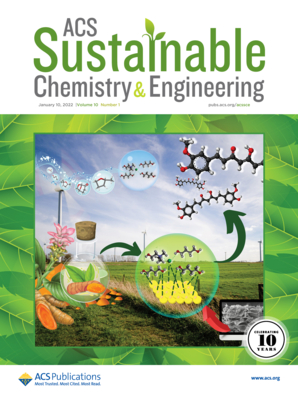Fine-Tuning of Acidity in Hierarchical Zeolites for the Efficient Prins Cyclization Yielding Florol
IF 7.1
1区 化学
Q1 CHEMISTRY, MULTIDISCIPLINARY
引用次数: 0
Abstract
In this contribution, several hierarchical zeolites comprising mainly Brønsted acid sites with different morphologies (nanosheets, nanoparticles, nanorods) were synthesized and applied to the efficient synthesis of the perfume Florol (2-isobutyl-4-methyl-tetrahydro-2H-pyran-4-ol) via Prins cyclization of isoprenol and isovaraldehyde. Tuning the acidity in a zeolite was done by either incorporating metal centers or changing the initial composition and crystallization time. Furthermore, the interplay among the pore structure, specific mesoporosity, and accessibility of acidic sites is crucial for optimizing Florol synthesis. Strong Brønsted acid sites enhance the formation of the dehydration products, while mild-acidic Brønsted acid sites with a medium strength of accessible acid sites improve the formation of Florol. A maximum Florol yield of ca. 80% was achieved with Al-MFI and Al-FER (only 30 min) with typical nanosheet (nsh) morphology; in addition, values of TOF in the order of 1121 and 2655 h–1, respectively, were also achieved. Al-FER-nsh showed itself to be robust, because it can be reused several times without any apparent loss of its catalytic activity. Finally, different green chemistry parameters were also applied to the studied zeolites in the synthesis of Florol, suggesting the high efficiency of the best catalyst (Al-MFI-nsh).

微调分层沸石中的酸度以实现高效的普林斯环化反应,产生弗洛里酚
在这篇论文中,合成了几种主要由不同形态(纳米片、纳米颗粒、纳米棒)的布氏酸位点组成的分层沸石,并将其应用于通过异戊烯醇和异戊醛的普林斯环化反应高效合成香水 Florol(2-异丁基-4-甲基-四氢-2H-吡喃-4-醇)。通过加入金属中心或改变初始成分和结晶时间,可以调节沸石的酸度。此外,孔隙结构、特定介孔率和酸性位点的可及性之间的相互作用对于优化弗罗洛尔合成至关重要。强勃氏酸位点能促进脱水产物的形成,而具有中等可触及酸位点强度的弱勃氏酸位点则能改善弗罗洛尔的形成。具有典型纳米片(nsh)形态的 Al-MFI 和 Al-FER(仅需 30 分钟)的 Florol 产率最高可达约 80%;此外,TOF 值也分别达到了 1121 和 2655 h-1 的数量级。Al-FER-nsh 具有很强的稳定性,因为它可以重复使用多次而不会明显丧失催化活性。最后,在合成 Florol 的过程中,还对所研究的沸石采用了不同的绿色化学参数,这表明最佳催化剂(Al-MFI-nsh)具有很高的效率。
本文章由计算机程序翻译,如有差异,请以英文原文为准。
求助全文
约1分钟内获得全文
求助全文
来源期刊

ACS Sustainable Chemistry & Engineering
CHEMISTRY, MULTIDISCIPLINARY-ENGINEERING, CHEMICAL
CiteScore
13.80
自引率
4.80%
发文量
1470
审稿时长
1.7 months
期刊介绍:
ACS Sustainable Chemistry & Engineering is a prestigious weekly peer-reviewed scientific journal published by the American Chemical Society. Dedicated to advancing the principles of green chemistry and green engineering, it covers a wide array of research topics including green chemistry, green engineering, biomass, alternative energy, and life cycle assessment.
The journal welcomes submissions in various formats, including Letters, Articles, Features, and Perspectives (Reviews), that address the challenges of sustainability in the chemical enterprise and contribute to the advancement of sustainable practices. Join us in shaping the future of sustainable chemistry and engineering.
 求助内容:
求助内容: 应助结果提醒方式:
应助结果提醒方式:


